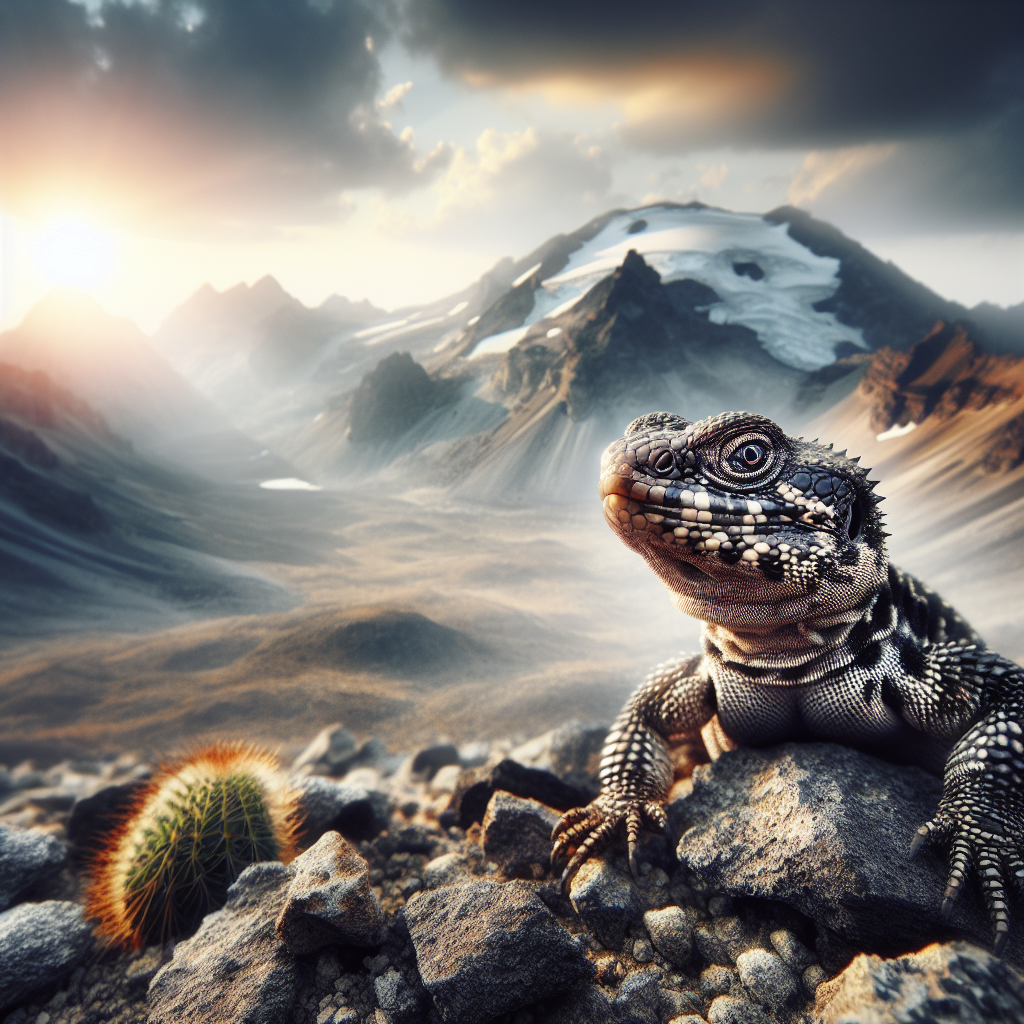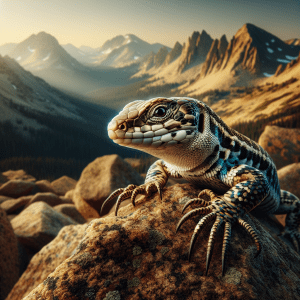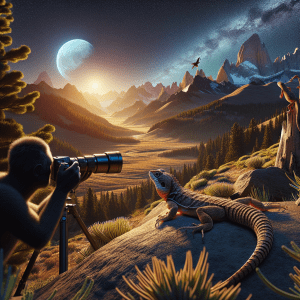Introduction: Exploring Rocky Mountain Lizard Fieldwork
Have you ever wondered what makes Rocky Mountain lizards so intriguing? Well, let me tell you, it’s a wild ride! Picture this: you’re trekking through the rugged terrain of the Rockies, your eyes scanning the rocky outcrops for any sign of these elusive creatures. Suddenly, you spot a flash of movement – a lizard darting across the path in front of you. It’s moments like these that make fieldwork in the Rocky Mountains so exhilarating.
The diversity of lizard species in this region is astounding. From the agile collared lizard to the cryptic horned lizard, each species has its own unique adaptations and behaviors that make them a joy to study. Did you know that some Rocky Mountain lizards can change color to blend in with their surroundings, a handy trick for avoiding predators?
But fieldwork in the Rockies isn’t all fun and games. As any seasoned researcher will tell you, the unpredictable weather and challenging terrain can present some serious obstacles. Imagine trying to conduct a lizard survey during a sudden mountain storm – talk about a test of your perseverance!
Despite the challenges, the insights gained from Rocky Mountain lizard fieldwork are invaluable. By studying these creatures up close, we can better understand their role in the ecosystem and work towards their conservation. So, next time you’re out hiking in the Rockies, keep an eye out for these fascinating creatures – you never know what you might discover!
Importance of Studying Lizards in the Rocky Mountains
Have you ever marveled at the diverse array of lizard species that call the Rocky Mountains home? These fascinating creatures have adapted to thrive in this unique environment, each species with its own set of characteristics and behaviors that contribute to the rich biodiversity of the region.
One interesting fact about studying lizards in the Rocky Mountains is the variety of habitats they inhabit. From rocky outcroppings to lush meadows, these resilient creatures have carved out their niches in the diverse landscapes of the Rockies. As a field researcher, I have had the privilege of observing these lizards up close in their natural habitats, witnessing their interactions and behaviors firsthand.
Understanding the importance of studying lizards in the Rocky Mountains goes beyond mere fascination—it plays a crucial role in conservation efforts and ecosystem management. By gaining insights into their behavior, habitat preferences, and population dynamics, researchers can develop strategies to protect these species and preserve their natural habitats for future generations to enjoy.
As you delve into the world of Rocky Mountain lizard fieldwork, you’ll discover the thrill of uncovering new insights, the challenges of conducting research in remote locations, and the satisfaction of contributing to our understanding of these remarkable creatures. So, join me on this journey of exploration and discovery as we unravel the mysteries of the Rocky Mountain lizards together.
Types of Lizards Found in the Rocky Mountain Region
As we delve into the types of lizards found in the Rocky Mountain region, it’s like entering a diverse and enchanting world. From the vibrant Western Fence Lizard basking in the sun to the elusive Northern Alligator Lizard hiding among the rocks, each species has its unique charm and role in the ecosystem.
Imagine stumbling upon a Western Skink darting across the trail or observing a Sagebrush Lizard blending seamlessly into its surroundings. These encounters offer glimpses into the intricate lives of these fascinating creatures. Did you know that the Great Basin Collared Lizard can reach speeds of up to 16 miles per hour when sprinting to escape predators? Nature never ceases to amaze with its marvels.
Exploring the variety of lizards in the Rocky Mountains provides not only a visual feast but also a deeper understanding of biodiversity and adaptation. Have you ever wondered how these creatures have evolved to thrive in such diverse landscapes? Their survival strategies and interactions with their environment offer valuable insights into the delicate balance of nature.
From the tiny Pygmy Short-horned Lizard to the majestic Greater Earless Lizard, each species has a story to tell. As we uncover the secrets of these remarkable reptiles, we gain a newfound appreciation for the rich tapestry of life that surrounds us. So, next time you venture into the Rocky Mountain wilderness, keep your eyes peeled for these wondrous creatures – you never know what enchanting encounter awaits you.
Fieldwork Techniques and Methods Used in Lizard Research
Fieldwork Techniques and Methods Used in Lizard Research
When it comes to studying lizards in the Rocky Mountains, we need to get our hands dirty – literally! Imagine trekking through rugged terrains, equipped with tools and a keen eye for spotting these elusive creatures. One of the most effective methods used in lizard fieldwork is radio telemetry. This high-tech approach involves attaching small radio transmitters to lizards to track their movements and behavior in their natural habitat. It’s like playing a real-life game of hide-and-seek with our scaly friends!
Another common technique is the good old-fashioned lizard trapping. Picture setting up traps baited with tasty treats like insects to lure in the lizards. Once captured, researchers can collect valuable data on the lizard population, species diversity, and individual characteristics. It’s like hosting a lizard party, but for science!
Now, here’s where it gets interesting. Have you heard of the “lizard sprint race” method? Researchers use this technique to measure the speed and agility of lizards in the wild. It’s a thrilling sight to see these tiny creatures dash across the rocky terrain, showcasing their impressive athleticism. Who knew lizards were such sprint champions?
So, the next time you spot a lizard basking in the sun on a Rocky Mountain trail, remember the incredible fieldwork techniques that help us unravel the mysteries of these fascinating creatures. From radio telemetry to lizard trapping and sprint races, there’s a whole world of discovery waiting for those willing to venture into the wild world of lizard research.
Challenges Faced During Rocky Mountain Lizard Fieldwork
Fieldwork in the Rocky Mountains studying lizards isn’t just about science—it’s an adventure! Picture this: you’re hiking through rugged terrain, scanning the rocky outcrops for signs of movement. Suddenly, you spot a flash of color and freeze, trying not to startle the elusive creature. It’s moments like these that make fieldwork exhilarating and unpredictable.
One interesting fact about Rocky Mountain lizards is their remarkable ability to adapt to extreme environments. From the swift and agile fence lizards to the cryptic camouflage of the sagebrush lizard, each species has evolved unique traits to thrive in this challenging landscape. As researchers, we’re constantly amazed by the resilience and diversity of these fascinating creatures.
But fieldwork isn’t all smooth sailing. One of the biggest challenges we face is the unpredictable weather in the Rockies. One minute, we’re basking in the sunshine, and the next, we’re scrambling for cover as a sudden storm rolls in. Despite the obstacles, our passion for studying these lizards drives us to persevere and unravel the mysteries of their lives.
As you delve into the world of Rocky Mountain lizard fieldwork, consider this: what can we learn from these resilient creatures about adaptation and survival in the face of adversity? Join us on this thrilling journey of discovery, where every encounter with a lizard brings us closer to understanding the intricate web of life in the Rocky Mountains.
Significant Discoveries and Insights from Fieldwork
Picture this – a vast expanse of rugged terrain in the Rocky Mountains, where every rock and crevice holds secrets waiting to be uncovered. As an expert in Rocky Mountain lizard fieldwork, I’ve had my fair share of thrilling encounters and groundbreaking discoveries.
One memorable experience that comes to mind is when we stumbled upon a rare species of lizard camouflaged among the rocky outcrops. It was a moment of pure excitement and wonder, knowing that we were witnessing something truly special in the wild.
The fieldwork involved in studying lizards in the Rocky Mountains is not for the faint of heart. From navigating treacherous terrain to enduring extreme weather conditions, each day presents its own set of challenges. But it is these very challenges that make the journey so rewarding and the discoveries so satisfying.
Did you know that some lizards in the Rocky Mountains have developed unique adaptations to survive in their harsh environment? From changing color to blend in with their surroundings to regrowing lost tails as a defense mechanism, these creatures never cease to amaze with their resilience and ingenuity.
So, as you delve into the world of Rocky Mountain lizard fieldwork, remember to tread lightly, observe keenly, and embrace the sense of wonder that comes with each new discovery. The thrill of uncovering the secrets of these fascinating creatures is an experience like no other, and I invite you to join me on this adventure of a lifetime.
Conservation Efforts for Rocky Mountain Lizard Species
Conservation efforts for Rocky Mountain lizard species are crucial in safeguarding their populations for future generations. Imagine being able to contribute to the protection of these fascinating creatures through fieldwork and research. It’s not just about studying them; it’s about actively working towards their survival in their natural habitats.
By understanding the specific needs and behaviors of Rocky Mountain lizards, we can tailor conservation strategies to address their vulnerabilities and promote their well-being. Each discovery made during fieldwork provides valuable insights that can guide conservation initiatives and inform decision-making processes.
Consider this: Did you know that some Rocky Mountain lizard species are facing habitat loss due to human activities? This poses a significant challenge to their survival, making conservation efforts all the more urgent. How can we balance human needs with the preservation of these unique reptiles in their natural environment?
As you delve into the world of Rocky Mountain lizard fieldwork, think about how your actions today can impact the future of these species. Your involvement in conservation efforts can make a real difference in ensuring that Rocky Mountain lizards continue to thrive in the wild. So, let’s embark on this journey together and make a positive impact on the conservation of these remarkable creatures.
Future Directions in Lizard Fieldwork Research
Imagine being out in the Rocky Mountains, surrounded by stunning scenery and the thrill of searching for elusive lizards. This is where the magic of lizard fieldwork truly comes to life. The techniques and methods used in this research field are as diverse as the lizards themselves. From setting up camera traps to conducting habitat surveys, every method offers a unique perspective on the lives of these fascinating creatures.
One practical tip that seasoned fieldworkers often emphasize is the importance of patience. Lizards are masters of camouflage, blending seamlessly into their surroundings. It takes a keen eye and a calm demeanor to spot these creatures in their natural habitat. So, slow down, observe your surroundings, and be prepared to wait for that perfect moment when a lizard reveals itself.
Moreover, the discoveries made during Rocky Mountain lizard fieldwork are not just about scientific data. They also tell stories of resilience, adaptation, and coexistence in this rugged environment. Each lizard species has its own tale to tell, adding to the rich tapestry of biodiversity in the Rockies.
As you delve deeper into the world of Rocky Mountain lizard fieldwork, you’ll find yourself immersed in a world where every rock, every bush, and every rustle of leaves could lead to a new discovery. So, grab your gear, head out into the wilderness, and let the adventure begin!
Tips for Participating in Rocky Mountain Lizard Fieldwork
Imagine being out in the Rocky Mountains, surrounded by breathtaking scenery and the intriguing world of lizards. As someone deeply passionate about lizard fieldwork, I can tell you that participating in such research activities is a truly enriching experience.
One practical tip I would offer to anyone interested in Rocky Mountain lizard fieldwork is to always be prepared for unexpected challenges. Whether it’s unpredictable weather conditions, difficult terrain, or elusive lizard species, fieldwork can be full of surprises.
I remember one particular expedition where we encountered a rare lizard species that had never been documented in that area before. It was a thrilling moment that highlighted the importance of fieldwork in expanding our knowledge of these fascinating creatures.
The significance of engaging in Rocky Mountain lizard fieldwork goes beyond the thrill of discovery. By studying these creatures in their natural habitat, researchers can gain valuable insights into their behavior, ecology, and conservation needs. This knowledge is crucial for developing effective conservation strategies to protect these unique species for future generations.
So, if you’re considering participating in Rocky Mountain lizard fieldwork, remember to stay curious, be prepared for challenges, and embrace the wonder of exploring the natural world. The rewards of contributing to our understanding of these remarkable creatures are truly immeasurable.
Conclusion: Embracing the Fascinating World of Rocky Mountain Lizard Fieldwork
Have you ever wondered about the incredible world of Rocky Mountain lizards and the fieldwork involved? Let me take you on a journey through the rugged terrains of the Rockies, where these fascinating creatures thrive.
Picture this: you’re trekking through the majestic Rocky Mountains, carefully observing the diverse species of lizards that call this region home. As an expert in Rocky Mountain lizard fieldwork, I’ve had my fair share of unforgettable encounters with these agile reptiles.
Did you know that some species of lizards in the Rocky Mountains have developed unique adaptations to survive in harsh environments? From camouflage techniques to efficient hunting strategies, these creatures never cease to amaze me.
One of the biggest challenges in studying Rocky Mountain lizards is tracking their elusive movements in the vast wilderness. Patience and keen observation skills are key when conducting fieldwork in this rugged terrain.
If you’re planning to embark on your own Rocky Mountain lizard fieldwork adventure, remember to pack essential gear such as sturdy boots, a field journal, and a reliable camera to document your discoveries.
Now, imagine the thrill of uncovering new insights into the behavior and ecology of these ancient reptiles. Each fieldwork expedition holds the promise of unraveling mysteries and contributing to our understanding of the natural world.
So, are you ready to join me on this exhilarating journey into the heart of Rocky Mountain lizard fieldwork? Together, we’ll delve into the depths of nature’s wonders and embrace the magic of scientific exploration.




